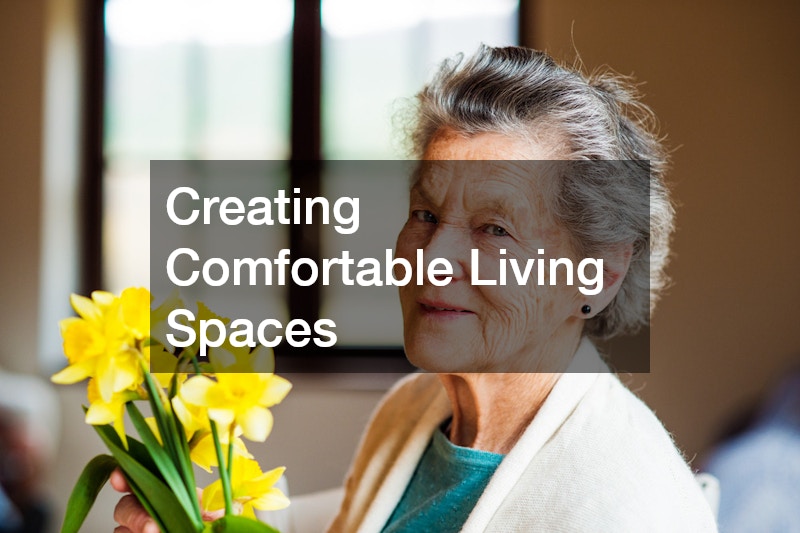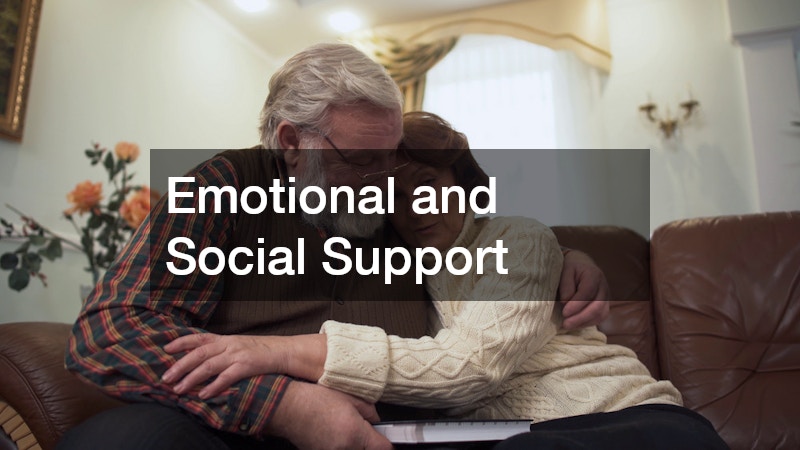As our loved ones age, their needs evolve, and the home environment they once navigated effortlessly may start to present challenges. Everyday tasks—climbing stairs, moving around furniture, reaching kitchen shelves—can suddenly become risky. Preparing your home for aging family members is not just about safety; it’s about preserving comfort, independence, and dignity.
The key to a smooth transition lies in planning ahead. Minor adjustments in your living space can prevent injuries, reduce stress, and create a more welcoming, accessible environment. From optimizing mobility to ensuring proper lighting and air quality, every change can significantly enhance daily life.
This guide offers practical, actionable advice for creating a home that supports aging loved ones, ensuring both safety and comfort. By taking a thoughtful, comprehensive approach, you can help your family members maintain independence while fostering peace of mind for everyone involved.
1. Assessing Your Home’s Safety Risks
The first step in preparing your home is a thorough assessment. Older adults are more susceptible to falls, slips, and accidents, so identifying potential hazards is crucial. Conducting a detailed evaluation of each room helps you pinpoint problem areas that could compromise safety, and it gives you a roadmap for necessary modifications. This assessment should go beyond obvious dangers and consider subtler risks such as poor lighting, uneven surfaces, and furniture arrangements that might impede mobility. Involving your aging loved one in the evaluation can also provide insight into areas they find challenging or uncomfortable in their daily routines.
Key Areas to Evaluate:
-
Floors and rugs: Uneven flooring, loose rugs, or slippery surfaces increase the risk of falls. Consider non-slip mats and remove clutter.
-
Lighting: Poorly lit areas, especially staircases and hallways, can be dangerous. Install motion-sensor night lights to guide nighttime movements.
-
Stairs and handrails: Check for stability and ensure railings extend the full length of stairs. Adding non-slip treads can also help prevent falls.
Practical Steps for a Safer Home:
-
Keep pathways clear and free of cords or small furniture.
-
Ensure furniture placement allows for easy navigation, particularly for walkers or wheelchairs.
-
Consider working with home remodelers to adapt spaces for long-term safety, such as widening doorways or reinforcing floors.
-
Consult senior care services for a professional assessment—they can identify risks you may overlook.
A proactive safety evaluation is the foundation for a secure home. Small interventions now can prevent accidents later, making the environment safer and more manageable for your loved ones.
2. Planning for Accessibility and Mobility
Accessibility is a core component of a senior-friendly home. As people age, changes in strength, balance, and coordination can make everyday tasks more challenging. Thoughtful planning ensures that daily routines—like moving between rooms, reaching items, or using the bathroom—remain manageable and safe. Accessibility improvements not only reduce the risk of injury but also promote independence, allowing your loved ones to maintain dignity and confidence in their own space.Accessibility is a core component of a senior-friendly home. Aging can limit mobility, so thoughtful planning ensures daily routines remain manageable.
Key Considerations:
-
Doorways and hallways: Ensure sufficient width for walkers or wheelchairs. Remove obstacles that can hinder movement.
-
Furniture layout: Arrange furniture to allow for clear, straight paths. Avoid sharp corners or unstable chairs.
-
Ramps and stairlifts: Install ramps at entrances and consider stairlifts for multi-level homes.
Making Your Home Easy to Navigate:
-
Use lever-style door handles instead of round knobs for easier operation.
-
Install sliding doors where possible to reduce the need to push heavy doors open.
-
Mount televisions and monitors at comfortable eye level using a reliable tv mounting service to prevent neck strain.
By planning for accessibility, you ensure your loved one can navigate their home safely, promoting independence while reducing the risk of injury.
3. Creating Comfortable Living Spaces

A safe home is only part of the equation; comfort is equally important. As adults age, they often spend more time at home, and even small discomforts—like a hard chair, a poorly lit room, or fluctuating temperatures—can significantly affect their quality of life. Creating spaces that are both safe and comfortable helps reduce fatigue, improve mood, and promote overall well-being. Thoughtful attention to furniture, lighting, and room layout can make everyday activities much easier and more enjoyable.
Key Areas for Comfort:
-
Seating: Choose chairs with supportive cushions and armrests. Recliners with adjustable positions can ease back and joint strain.
-
Bedroom: A high-quality mattress that provides adequate support can improve sleep and reduce discomfort.
-
Lighting and temperature: Adjust lighting levels to reduce glare and strain, and ensure rooms are comfortably heated or cooled.
Enhancing Everyday Comfort:
-
Use contrasting colors for furniture, floors, and walls to help those with visual impairments navigate more easily.
-
Keep frequently used items within easy reach to minimize unnecessary bending or stretching.
-
Regular air conditioning service ensures consistent climate control, which is particularly important for seniors sensitive to heat or cold.
-
Partner with senior care services to evaluate overall comfort needs and suggest modifications.
Comfortable living spaces reduce stress, promote relaxation, and contribute to the overall well-being of aging family members.
4. Kitchen and Dining Adjustments
The kitchen is one of the most frequently used areas in a home, yet it can pose significant hazards for older adults. Slippery floors, hard-to-reach items, and heavy appliances all increase the risk of accidents. Adjusting the kitchen for both safety and ease of use is essential, as it allows seniors to maintain independence, continue preparing meals, and enjoy social interactions around food without unnecessary stress or danger. Thoughtful planning can also reduce fatigue and make cooking and dining more enjoyable.
Key Considerations:
-
Flooring: Non-slip surfaces prevent falls during meal preparation.
-
Cabinets and drawers: Lower shelves and pull-out drawers make items more accessible without stretching or climbing.
-
Appliances: Ensure appliances are easy to operate, with clear labels and ergonomic handles.
Designing a Safer, More Accessible Kitchen:
-
Use adaptive utensils and lightweight cookware to make meal preparation manageable and reduce strain on hands, wrists, and arms. Tools with ergonomically shaped handles or non-slip grips can make a big difference for seniors with arthritis or limited dexterity.
-
Install task lighting under cabinets to illuminate countertops and cooking areas. Proper lighting reduces eye strain, helps prevent accidents, and makes food preparation safer and more precise.
-
Schedule regular visits with a family dentist to maintain oral health. Good dental health is linked to proper nutrition, and untreated dental issues can make it difficult to eat safely or enjoy meals.
-
Encourage routine ear examination to detect hearing problems. Seniors with diminished hearing may not hear timers, alarms, or other important kitchen signals, which could lead to accidents or overcooked food.
By adjusting the kitchen layout and workflow, seniors can maintain independence in meal preparation while minimizing risks.
5. Bathroom Safety and Accessibility
Bathrooms are among the most hazardous areas for older adults, with wet surfaces, hard edges, and confined spaces posing serious risks. Slips and falls are common in this space, and even minor accidents can lead to significant injuries. Making the bathroom safe and accessible is therefore a priority, as it allows seniors to maintain independence and personal hygiene with confidence while reducing stress for caregivers.
Key Considerations:
-
Walk-in tubs and showers: These reduce the risk of slipping when entering or exiting.
-
Grab bars: Install near toilets, showers, and tubs to provide stability.
-
Non-slip mats: Place inside and outside the shower area to prevent slips.
Tips for a Secure and Comfortable Bathroom:
-
Consider a shower chair for those with limited endurance or balance issues. This allows for safer bathing without fatigue or strain.
-
Use a handheld showerhead with a long hose, which makes bathing easier and reduces the need to move around too much.
-
Encourage regular eye exams to identify vision changes that could increase the risk of slips or misjudging distances in the bathroom. Proper vision is critical for safe navigation, especially in wet or reflective environments.
-
For seniors with advanced health concerns, hospice at home services can provide additional support in the bathroom and throughout daily routines. This ensures that care needs are met safely and compassionately, even during end-of-life care.
-
Organize frequently used items—soap, shampoo, towels—within easy reach to avoid unnecessary bending or stretching, which can destabilize balance.
A bathroom that combines safety features with accessibility allows seniors to maintain dignity and independence while minimizing fall risks.
6. Health and Wellness Planning

Maintaining physical and mental health is crucial for aging adults. A structured approach to wellness can prevent many common age-related complications.
Key Components:
-
Medical check-ups: Routine visits to primary care providers, specialists, and vision or hearing professionals.
-
Medication management: Organize daily doses with labeled pillboxes or smart dispensers.
-
Nutrition and exercise: Encourage a balanced diet and light physical activity to promote mobility and overall health.
Building a Routine for Better Health:
-
Create a weekly schedule that incorporates medical appointments, exercise, social activities, and meal planning. A consistent routine supports mental clarity and reduces anxiety or confusion.
-
Maintain an organized record of medications, allergies, and health history in a readily accessible location. This is especially helpful in emergencies or when caregivers or healthcare providers are involved.
-
Consult estate planning lawyers to ensure that legal and financial documents are up to date. Planning for wills, powers of attorney, and healthcare directives reduces stress for both seniors and their families and ensures that long-term wishes are respected.
-
Utilize senior care services to coordinate ongoing care, wellness check-ins, and support for transportation to appointments. These services can also provide guidance on nutrition, exercise, and adaptive equipment for daily living.
Prioritizing health and wellness ensures a higher quality of life and reduces the likelihood of emergencies or preventable complications.
7. Enhancing Home Technology and Safety Systems
Technology can play a pivotal role in maintaining safety, comfort, and independence for aging loved ones. Modern solutions—from emergency response systems to smart home devices—help seniors live confidently while providing peace of mind for family members. Thoughtful integration of technology enhances daily routines, reduces risk, and can even support social engagement and mental stimulation.
Key Solutions:
-
Emergency response systems: Devices that alert caregivers or medical personnel in case of a fall or emergency.
-
Home monitoring: Cameras and sensors provide peace of mind without being intrusive.
-
Comfort-enhancing tech: Smart thermostats, air conditioning service alerts, and automated lighting.
Leveraging Technology for Safety and Comfort:
-
Mount televisions at an ergonomic height using a tv mounting service. Proper placement prevents neck strain, reduces the risk of tipping, and ensures clear visibility from seating areas without awkward positioning.
-
Consider simple communication devices, such as large-button phones, tablets with video calling, or voice-activated assistants. These tools make it easy for seniors to stay connected with family, schedule appointments, and access reminders.
-
Integrate motion-sensor lighting in hallways, bathrooms, and entryways to prevent nighttime accidents and guide safe navigation.
-
Schedule regular air conditioning service to maintain consistent indoor temperatures. This is especially important for seniors with heart, lung, or respiratory conditions, as sudden temperature fluctuations can have a serious impact on health.
-
Explore additional technology, such as smart pill dispensers, which provide reminders and monitor adherence to medication schedules, further supporting wellness and independence.
Modern technology can make a home safer, more comfortable, and more manageable for aging residents.
8. Preparing for Emergencies and Long-Term Needs
Emergencies—whether medical, natural, or unexpected—require proactive planning, especially when caring for aging loved ones. A well-prepared home can significantly reduce stress, prevent injuries, and ensure a timely response when challenges arise. Planning ahead is not just about reacting to emergencies; it’s about creating a sense of security for seniors and their families.
Key Steps:
-
Emergency contacts: Keep a list of local hospitals, doctors, and family members in an accessible place.
-
First-aid kits: Include medications, bandages, and emergency tools.
-
Evacuation plans: For natural disasters, create a step-by-step procedure that accounts for mobility limitations.
Planning Ahead for Emergencies:
-
Consider local senior movers if a relocation becomes necessary due to health or mobility concerns. These professionals specialize in safely and efficiently moving seniors and their belongings while minimizing physical strain on both the senior and the family.
-
Work with home remodelers to make long-term accessibility improvements that also enhance safety during emergencies, such as widening hallways, installing ramps, or reinforcing exits.
-
Label all utility shut-offs and safety switches clearly so they can be accessed quickly during emergencies. This includes water, gas, and electricity, as well as heating or air conditioning systems.
-
Keep essential medical records, legal documents, and medication lists in a secure but easily accessible location. This ensures quick reference during an emergency and prevents delays in care.
Being prepared ensures your aging loved ones can respond to emergencies safely and with confidence.
9. Emotional and Social Support

Safety and comfort are essential components of a senior-friendly home, but emotional and social well-being are just as important. Social isolation can contribute to depression, cognitive decline, and decreased motivation for daily activities. Supporting the emotional needs of aging loved ones helps maintain mental health, encourages engagement, and fosters a sense of purpose and belonging.
Key Strategies:
-
Encourage social engagement: Invite friends or family over regularly, participate in community programs, or join clubs.
-
Create hobby areas: Set up spaces for reading, art, puzzles, or music.
-
Maintain routines: Regular schedules promote stability and mental clarity.
Fostering Emotional Well-Being and Social Engagement:
-
Schedule routine eye exams to detect vision changes that might limit participation in social or recreational activities. Adequate vision is critical for reading, hobbies, and safely navigating social spaces.
-
Regular visits to a family dentist support oral health, which can influence nutrition, speech, and self-confidence. Healthy teeth and gums also reduce discomfort that may interfere with social interactions.
-
Organize activities that encourage cognitive stimulation, such as memory games, word puzzles, or group discussions. Mental engagement strengthens brain function and reduces the risk of cognitive decline.
-
Foster intergenerational interaction by involving grandchildren, younger relatives, or community volunteers. Sharing stories, teaching skills, or simply spending time together helps seniors feel valued and connected.
A well-rounded approach that includes emotional support enhances quality of life and encourages continued engagement in home and community life.
10. Professional Services and Long-Term Planning
Engaging professionals is a smart strategy for ensuring a safe, comfortable, and legally sound environment for aging loved ones.
Key Services:
-
Remodeling and repairs: Home remodelers can make spaces more accessible and safer for seniors.
-
In-home care and hospice: Specialized services provide medical and emotional support when needed.
-
Legal and financial planning: Estate planning lawyers help secure assets and outline future care arrangements.
Partnering with Professionals for Long-Term Care:
-
Hire qualified experts for home modifications and consult them for ongoing maintenance needs. This can include safety inspections, accessibility improvements, and adaptive technology installation.
-
Explore hospice at home options if your loved one’s health requires advanced or end-of-life care. These services provide compassionate support, symptom management, and emotional guidance for both the senior and family members.
-
Schedule regular check-ins with senior care services to monitor evolving needs. These professionals can coordinate medical appointments, wellness assessments, and support services to maintain independence.
-
Keep all legal and financial documents up to date with the assistance of estate planning lawyers, including wills, trusts, and healthcare directives, to ensure long-term security and peace of mind.
Leveraging professional services ensures that every aspect of safety, comfort, and future planning is covered.
Conclusion
Preparing your home for aging loved ones is an ongoing, thoughtful process that balances safety, comfort, and emotional well-being. From mobility modifications and kitchen adjustments to emergency planning and professional support, each step contributes to a higher quality of life.
By addressing hazards, creating accessible and comfortable spaces, and planning for long-term needs, you can help your loved ones maintain independence, dignity, and happiness at home. Small changes today can have a lasting impact, creating a home environment that truly supports aging with grace and security.

